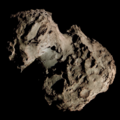C/1948 V1
Appearance
 The Eclipse Comet of 1948 photographed by W. C. Braun from the McDonald Observatory on November 14, 1948 | |
| Discovery[1] | |
|---|---|
| Discovery date | 1 November 1948 |
| Designations | |
| 1948 XI, 1948l[2] | |
| Orbital characteristics[3][4] | |
| Epoch | 10 January 1949 (JD 2432926.5) |
| Observation arc | 137 days |
| Number of observations | 17 |
| Aphelion | 3,149.44 AU |
| Perihelion | 0.1354 AU |
| Semi-major axis | 1,574.79 AU |
| Eccentricity | 0.9999 |
| Orbital period | 62,494.39 years |
| Inclination | 23.116° |
| 211.043° | |
| Argument of periapsis | 107.249° |
| Last perihelion | 27 October 1948 |
| TJupiter | 0.423 |
| Earth MOID | 0.1883 AU |
| Jupiter MOID | 1.8182 AU |
| Physical characteristics[5][7] | |
Mean radius | 1.531 km (0.951 mi)[a] |
| Comet total magnitude (M1) | 5.5 |
| Comet nuclear magnitude (M2) | 9.0 |
| –1.0 (1948 apparition)[6] | |
The Eclipse Comet of 1948, formally known as C/1948 V1, was an especially bright comet discovered during a solar eclipse on November 1, 1948. Although there have been several comets that have been seen during solar eclipses, the Eclipse Comet of 1948 is perhaps the best-known; it was however, best viewed only from the Southern Hemisphere.
When it was first discovered during totality, it was already quite bright, at magnitude –1.0; as it was near perihelion, this was its peak brightness.[8] Its visibility during morning twilight improved as it receded outward from the Sun; it peaked near zero magnitude, and at one point displayed a tail roughly 30 degrees in length, before falling below naked eye visibility by the end of December.[8]
References
[edit]Notes
[edit]Citations
[edit]- ^ J. M. Vinter Hansen, ed. (9 November 1948). "Bright New Comet (1948l)". IAU Circular. 1186 (4).
- ^ "Comet Names and Designations". International Comet Quarterly. Retrieved 19 June 2025.
- ^ Horizons output. "Barycentric Osculating Orbital Elements for Comet C/1948 V1 (Eclipse Comet)". ssd.jpl.nasa.gov. Jet Propulsion Laboratory. Retrieved 3 February 2011. (Solution using the Solar System Barycenter and barycentric coordinates. Select Ephemeris Type:Elements and Center:@0)
- ^ "C/1948 V1 (Eclipse Comet) – JPL Small-Body Database Lookup". ssd.jpl.nasa.gov. Jet Propulsion Laboratory. Retrieved 9 November 2024.
- ^ a b J. A. Fernández; A. Sosa (2012). "Magnitude and size distribution of long-period comets in Earth-crossing or approaching orbits". Monthly Notices of the Royal Astronomical Society. 423 (2): 1674–1690. arXiv:1204.2285. doi:10.1111/j.1365-2966.2012.20989.x.
- ^ "Comet C/1948 V1 (Eclipse Comet)". Comet Observation Database System (COBS). Retrieved 9 November 2024.
- ^ J. E. Bortle (1998). "The Bright Comet Chronicles". International Comet Quarterly. Retrieved 9 November 2024.
- ^ a b S. Odenwald. "When was the last time we had two bright comets in the same year?". Ask the Astronomer. Archived from the original on 15 February 2006. Retrieved 13 February 2006.
External links
[edit]- C/1948 V1 at the JPL Small-Body Database




